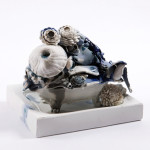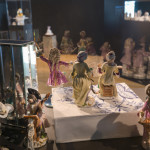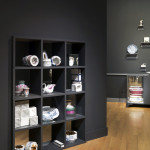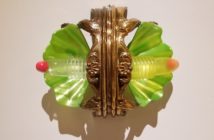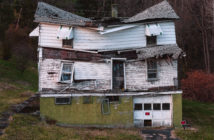These works are the products of the artist’s residency at the Meissen factory in Germany, a palace of production whose 18th century origins can be traced to the king of Poland’s insatiable desire for exotic porcelain. Created with the factory’s original molds, Shechet’s amorphous pieces are not quite vegetable, animal, or mineral, but something in between. The creations are exhibited alongside the museum’s collection of Meissen tableware and figurines, in both the contemporary gallery and in the period rooms of the museum’s Pendleton House.
Shechet’s work explores the dialectic exchange between the raw and the refined. Industrial excess is fused with the delicate and decorative; the result is a postmodern visual scramble of the original 18th century Meissen pieces. Shechet uses glazes instead of acrylic paint to "fuse the skin with the body" in the process of firing [1]. In her pieces, clay retains the memory of itself, preserving a sense of soft malleability. Her wild splotches of color, in the traditional Meissen palette, are punctuated with gold touches that recall Lynda Benglis as much as the gilded Baroque.
 Installation views of Arlene Shechet: Meissen Recast, January 17 —July 6, 2014. Photography by Erik Gould. Courtesy of the RISD Museum, Providence, RI.
Installation views of Arlene Shechet: Meissen Recast, January 17 —July 6, 2014. Photography by Erik Gould. Courtesy of the RISD Museum, Providence, RI.In her pursuit of abstraction, Shechet seems intent on dissolving the happy arcadia of the Meissen figures, shattering all those gay, barefoot maidens and winsome shepherds, the birds and flutes and baskets of flowers. The sylvan figures slip in and out of recognizability, becoming illegible, their artifice exposed. They seem to melt out of sense, in a state of becoming, reclaimed by the pure force of the material.
Shechet seems to unleash the barely restrained perversity within the original rococo pieces—one needs only to think of Fragonard’s The Swing, with all its implications of voyeurism and sexual misconduct, to sense the Rabelaisian mischief curled up within these prissy and genteel figurines. This implied voyeurism is echoed in Shechet’s placement of mirrors beneath some of the pieces, as if the viewer were "looking up the skirt" to glimpse the hollow interior of the figure, the rarely seen mold. The mirrors, for all their Freudian implications, present a kind of funhouse disorientation. They offer not any kind of self-identification or reflection, but a way of looking askew, a refracted vision through which no clear or obvious answers are found. Shechet’s figures, bordering on the monstrous, are an assault on rationality.
 Installation views of Arlene Shechet: Meissen Recast, January 17 —July 6, 2014. Photography by Erik Gould. Courtesy of the RISD Museum, Providence, RI.
Installation views of Arlene Shechet: Meissen Recast, January 17 —July 6, 2014. Photography by Erik Gould. Courtesy of the RISD Museum, Providence, RI.Shechet’s agenda is also a formalist one as she experiments with the classic preoccupations of sculpture: the precarities of gravity, volume, mass, and scale. As in her previous shows, her sculptures veer on the brink of collapse, always at the tipping point. Her ethos is painterly and improvisational; elsewhere, she has called clay a "three-dimensional drawing material," emphasizing the physicality of the medium, the primal connection to the body. Like Pollock, she is said to eschew traditional tools, preferring instead to work directly with her hands. Indeed, the work owes much to abstract expressionism in its exaltation of the gestural and accidental, celebrating clay not for its mimetic or ornamental possibilities but, in the words of critic Harold Rosenberg, "as in arena in which to act."
As art objects rather than decoration, the pieces make greater claims on space. While Meissen porcelain is normally contained in airless vitrines or placed in decorative wall hangings—two exhibitionary languages, museal and domestic, which Shechet references—it is the uneven, free-form space of the art installation that these pieces primarily occupy.
The arrangement of the gallery itself feels jagged and haphazard, as if the broken narrative of the Meissen characters was also spatially manifest. In the museum’s Porcelain Gallery, Schechet softly undermines the conventional modes of display, creating in the cases subtle scenes of disorder. As in previous shows, Shechet has crafted her own podiums—some out of concrete blocks—to introduce more questions about where the art begins and ends, where function leaves off and form prevails.
The RISD Museum is an ideal site to pose such questions. At once a university art museum, a regional art museum, and a house museum, the hybrid institution embodies the tensions between the fine and applied arts. In the past several years, both the museum and the art school have annexed the idea of "making" as an institutional calling card (the titles of the museum’s last few major exhibitions contained some variant of the verb to make). It appears "making" has emerged as a catchphrase loose enough to accommodate forms of creative production at all rungs of the visual hierarchy—both past and present, product and process. The museum is dedicated to the celebration of art and craft, but also to exploring how the lines between the two are drawn.
 Installation views of Arlene Shechet: Meissen Recast, January 17 —July 6, 2014. Photography by Erik Gould. Courtesy of the RISD Museum, Providence, RI.
Installation views of Arlene Shechet: Meissen Recast, January 17 —July 6, 2014. Photography by Erik Gould. Courtesy of the RISD Museum, Providence, RI.Clay is a material that contains multitudes. In "Meissen Recast," viewers contemplate clay’s transformation from the most basic, earthen substance to an object of precious rarity. In juxtaposing clay in its wildest state with the elegant porcelain, Shechet leads us through all the material’s various incarnations: natural, industrial, ornamental. But above all, Shechet frees the medium from its servitude to the decorative, allows it to be matter again, draws it back to the body, and puts it in play as a sculptural element.
The work is performative rather than narrative, resisting any sweet and tidy anecdote—two lovers in love, a boy and his sheep, a merry band of monkey-faced players. Stories, after all, are civilizing forces, sculpting the raw and incoherent material of existence into a familiar shape. Stories are the process by which bodily sensation is rendered legible, and this is precisely the sort of domestication that Shechet undoes in her work.
- Installation views of Arlene Shechet: Meissen Recast, January 17 —July 6, 2014. Photography by Erik Gould. Courtesy of the RISD Museum, Providence, RI.
- Installation view of “Arlene Shechet: Meissen Recast,” January 17 – Sunday, July 6, 2014. Photography by Erik Gould. Courtesy of the RISD Museum, Providence, RI.
- Installation view of “Arlene Shechet: Meissen Recast,” January 17 – Sunday, July 6, 2014. Photography by Erik Gould. Courtesy of the RISD Museum, Providence, RI.
Notes
1. Esther, Beck. "Ceramics Entry into the Art Consensus: The Case of Arlene Shechet," Benyamini Contemporary Ceramics Center.
http://www.benyaminiceramics.org/en/2013/11/ceramics-entry-into-the-art-consensus-the-case-of-arlene-shechet/


